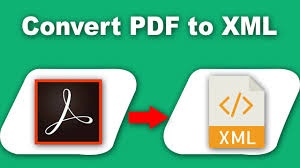PDF to XML Converter

Automated PDF to XML Transformation: Streamlining Data Extraction in the Digital Age
“PDF to XML”—Unlocking Structured Data from Documents
In the digital age, PDF stands as a cornerstone format for sharing finalized documents—from contracts and invoices to reports and manuals. Its fixed-layout nature ensures consistent rendering across devices, but it also makes data extraction notoriously difficult. That’s where PDF-to-XML conversion shines—transforming static documents into flexible, machine-readable data ready for automated processing.
- Structured Data Output
- XML (eXtensible Markup Language) wraps data in a hierarchical, tagged format, making it easy to parse and integrate with systems like CRMs, ERPs, or analytics platforms.
2. Workflow Automation
Once PDFs are converted into XML, you can automate downstream processes—like populating databases or triggering business logic—without manual intervention.
3. Interoperability
Unlike PDF, XML can be consumed by a wide variety of systems—from web services to custom applications—enhancing document interoperability across tech stacks.
Methods of Conversion
- Manual Tools: For quick jobs, tools like Adobe Acrobat allow selecting text and exporting to XML—right-click selection, then Export Selection As → XML. Adobe
- Online Converters: Free platforms like Aspose, UPDF, or Smallpdf offer quick, web-based PDF-to-XML conversions—just upload and download the XML. UPDF swifdoo.com
- APIs & Developer Tools: Platforms like PDF.co offer APIs to programmatically convert PDF into rich XML with metadata (font, position, etc.)—ideal for automation pipelines. PDF.co
Steps for an Effective Conversion Workflow
- Analyze the PDF.
- Identify whether it’s text-based or scanned. Scanned documents often require OCR preprocessing.
- Select the Right Tool.
- Use manual extraction for one-off tasks, online tools for quick conversions, or APIs for scaling and automation.
- Validate Output
- Check XML for structural integrity. Ensure tags align with your schema and that all recognizable elements are captured.
- Integrate via Workflow.
- Plug the XML into your backend—whether it’s a database ingest, transformation script, or ERP integration.
- Iterate & Optimize
- Improve accuracy by customizing extraction modes (line vs. word) or leveraging more advanced parsing tools if necessary.
Typical Use Cases
- Invoice & Billing Automation
- Convert invoices in PDF to XML for auto-entry into accounting systems.
- Legal Document Management
- XML outputs allow efficient archival, indexing, and metadata lookup.
- Data Extraction from Reports
- Retrieve structured insights (like tables and figures) for analytics.
- Form Processing
- Automate extraction of form fields from PDFs into structured datasets.
Challenges to Watch Out For
- Complex Layouts
- PDFs with rich layouts, tables, or columns may get misinterpreted.
- OCR Limits
- Poor scan quality can lead to text extraction errors—always validate accuracy.
- Schema Mismatch
- Ensure your XML output aligns with downstream data consumers to avoid integration hiccups.
Frequently Asked Questions (FAQ)
Q1: What is the difference between PDF and XML?
A: A PDF is a layout-preserving document format ideal for viewing, while XML is a structured, tag-based format designed for machine interpretation and interoperability.
Q2: Can I convert scanned PDFs to XML?
A: Yes—though you’ll first need OCR to extract text from scanned images. After that, the output can be structured into XML.
Q3: Are online converters safe to use?
A: Most reputable services use encryption and purge files after processing, but sensitive data should ideally be converted using offline tools or APIs you control.
Q4: Is XML the only target format?
A: No. Depending on your workflow, you could convert PDF to formats like CSV, JSON, or direct database records—XML is just one structured option.
Q5: Which tools do you recommend for developers?
A: APIs like PDF.co are excellent for automated pipelines. For simpler tasks, Aspose or UPDF offer easy, one-click conversions. PDF.co UPDF
This post has laid out why PDF to XML transformation matters, how to do it effectively, and what tools and pitfalls to consider. Want help choosing a tool for your specific workflow or developing an automation script? I’m happy to assist!